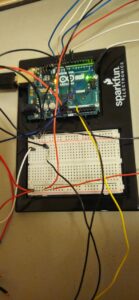Backstory: Giving Up, Trying Again and Moving Forward
I decided to work on my midterm project as it will be less time consuming, but unfortunately the project did not work according to my plan. I made this, which is a 3D flying game (well, was supposed to be a 3D flying game). I tried without sensors first to see if the graphics works well or not and showed this to my roommate as an user opinion, who said it might not be one of the best choices to add this as my final game. I still spend some more time on it but no luck!
Moving Forward:
After digging more on the feasibility of finishing a nicely done project and the limitations of sensors, I decided to change my project. As I am a fan of making something impactful (which I also criticise about myself because making something fun and relaxing can be an amazing accomplishment), I decided to take Sundarban Mangrove Forest as my game idea and the mythology of Bengal Region as my game.
Context of the myth:
In the Sundarbans myth, Bonbibi, the guardian goddess of the forest, defends the local woodcutters and honey gatherers from the malevolent tiger god, Dakshin Rai. The story highlights a young boy, Dukhey, who becomes a victim of a pact between his greedy employer and Dakshin Rai, aiming to sacrifice him to the tiger god. Bonbibi intervenes, rescuing Dukhey and ensuring his safe return, playing her role as a protector and mediator between the natural world and human interests.
Game flow:

User Testing:
Till this point, the game is done only at the initial stage. The design was done and the flex sensor was working correctly to go to first stage of the game. Graphics:


For the testing, people played only the very beginning part, and they liked it because of the idea and the graphics, which gave me some affirmation that yes, I can move forward with it.
I did second part of the game earlier as my flex sensors were working. This is the link to the second part, Bee, here the sensors were able to connect but calibrating two flex sensors, one for moving the bees and another one to collect honey, was not running smoothly. But, as it was somewhat working at least with keyboards, I kept it as my second part.
The third of the game while player needs to run away from the tiger was the crucial one where I keep two sonar sensors side by side and player needs to simulate steps like running, like when left sensor detects obstacles, the right sensor does not as the right leg is up. Again when the right sensor detects obstacles, left sensor does not because now as part of running the left leg is up and right leg is on the ground.
I created a dummy version first to implement the logic and some basic visuals, this one I liked as my logic worked with keyboard properly. Link to see the initial one. and the second draft done one. I was not satisfied with any of them.
Sensor connection on Arduino:

Unfortunately, I did not take any video but when my roommate tried to play the game, she was very confused with the sensors as it was not working properly.
Only the storyline of the experience was satisfying for her and also for my fellow classmates on saw my works on Wednesday.
I needed to explain my game that what I am trying to achieve. Moreover, as the sensor calibration was very troubling and the movements were very poor, I decided to make it easier.
Having different sensors for different stages, made it tough for users to understand what is happening and why does the user needs to use different sensors for different games. It was challenging from the circuit building to the end level of user testing as well.
I added clear instructions on how to play, what is the mythology about and what are the end goals. Moving on, I again needed to drop the plan of tiger and player chasing along with the bee but I did keep my plan with boat and two sensors.
To get rid of any risk, I followed simple mechanism and rules to build my final game. One thing I was sure after user testing that whoever heard the story or saw it, they all liked it. The only problem was how to design the game play.
